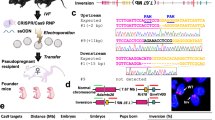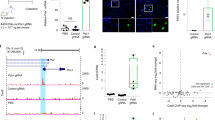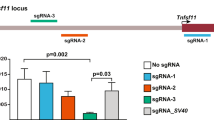Abstract
A large cis-regulatory landscape is a common feature of vertebrate genomes, particularly at key developmental gene loci with finely tuned expression patterns. Existing genetic tools for surveying large genomic regions of interest spanning over hundreds of kilobases are limited. Here we propose a chromosomal engineering strategy exploiting the local hopping trait of the Sleeping Beauty transposon in the mouse genome. We generated embryonic stem cells with a targeted integration of the transposon vector, carrying an enhancer-detecting lacZ reporter and loxP cassette, into the developmentally critical Pax1 gene locus, followed by efficient local transpositions, nested deletion formation and derivation of embryos by tetraploid complementation. Comparative reporter expression analysis among different insertion/deletion embryos substantially facilitated long-range cis-regulatory element mapping in the genomic neighborhood and demonstrated the potential of the transposon-based approach as a versatile tool for exploration of defined genomic intervals of functional or clinical relevance, such as disease-associated microdeletions.
This is a preview of subscription content, access via your institution
Access options
Subscribe to this journal
Receive 12 print issues and online access
$209.00 per year
only $17.42 per issue
Buy this article
- Purchase on Springer Link
- Instant access to full article PDF
Prices may be subject to local taxes which are calculated during checkout




Similar content being viewed by others
References
Kleinjan, D.A. & van Heyningen, V. Long-range control of gene expression: emerging mechanisms and disruption in disease. Am. J. Hum. Genet. 76, 8–32 (2005).
Ivics, Z., Hackett, P.B., Plasterk, R.H. & Izsvak, Z. Molecular reconstruction of Sleeping Beauty, a Tc1-like transposon from fish, and its transposition in human cells. Cell 91, 501–510 (1997).
Luo, G., Ivics, Z., Izsvak, Z. & Bradley, A. Chromosomal transposition of a Tc1/mariner-like element in mouse embryonic stem cells. Proc. Natl. Acad. Sci. USA 95, 10769–10773 (1998).
Horie, K. et al. Characterization of Sleeping Beauty transposition and its application to genetic screening in mice. Mol. Cell. Biol. 23, 9189–9207 (2003).
Keng, V.W. et al. Region-specific saturation germline mutagenesis in mice using the Sleeping Beauty transposon system. Nat. Methods 2, 763–769 (2005).
Santagati, F. et al. Identification of cis-regulatory elements in the mouse Pax9/Nkx2–9 genomic region: implication for evolutionary conserved synteny. Genetics 165, 235–242 (2003).
Wang, W., Zhong, J., Su, B., Zhou, Y. & Wang, Y.Q. Comparison of pax1/9 locus reveals 500-myr-old syntenic block and evolutionary conserved noncoding regions. Mol. Biol. Evol. 24, 784–791 (2007).
Wilm, B., Dahl, E., Peters, H., Balling, R. & Imai, K. Targeted disruption of Pax1 defines its null phenotype and proves haploinsufficiency. Proc. Natl. Acad. Sci. USA 95, 8692–8697 (1998).
Kokubu, C. et al. Undulated short-tail deletion mutation in the mouse ablates Pax1 and leads to ectopic activation of neighboring Nkx2–2 in domains that normally express Pax1. Genetics 165, 299–307 (2003).
Korzh, V. Transposons as tools for enhancer trap screens in vertebrates. Genome Biol. 8 (suppl. 1), S8 (2007).
Branda, C.S. & Dymecki, S.M. Talking about a revolution: the impact of site-specific recombinases on genetic analyses in mice. Dev. Cell 6, 7–28 (2004).
Kothary, R. et al. Inducible expression of an hsp68-lacZ hybrid gene in transgenic mice. Development 105, 707–714 (1989).
Cui, Z., Geurts, A.M., Liu, G., Kaufman, C.D. & Hackett, P.B. Structure-function analysis of the inverted terminal repeats of the sleeping beauty transposon. J. Mol. Biol. 318, 1221–1235 (2002).
Geurts, A.M. et al. Gene transfer into genomes of human cells by the sleeping beauty transposon system. Mol. Ther. 8, 108–117 (2003).
Ikeda, R. et al. Sleeping beauty transposase has an affinity for heterochromatin conformation. Mol. Cell. Biol. 27, 1665–1676 (2007).
Devon, R.S., Porteous, D.J. & Brookes, A.J. Splinkerettes–improved vectorettes for greater efficiency in PCR walking. Nucleic Acids Res. 23, 1644–1645 (1995).
Nagy, A., Rossant, J., Nagy, R., Abramow-Newerly, W. & Roder, J.C. Derivation of completely cell culture-derived mice from early-passage embryonic stem cells. Proc. Natl. Acad. Sci. USA 90, 8424–8428 (1993).
Valenzuela, L. & Kamakaka, R.T. Chromatin insulators. Annu. Rev. Genet. 40, 107–138 (2006).
Bejerano, G., Siepel, A.C., Kent, W.J. & Haussler, D. Computational screening of conserved genomic DNA in search of functional noncoding elements. Nat. Methods 2, 535–545 (2005).
Kondo, T. & Duboule, D. Breaking colinearity in the mouse HoxD complex. Cell 97, 407–417 (1999).
Su, H., Wang, X. & Bradley, A. Nested chromosomal deletions induced with retroviral vectors in mice. Nat. Genet. 24, 92–95 (2000).
Bilodeau, M., Girard, S., Hebert, J. & Sauvageau, G. A retroviral strategy that efficiently creates chromosomal deletions in mammalian cells. Nat. Methods 4, 263–268 (2007).
Wu, S., Ying, G., Wu, Q. & Capecchi, M.R. Toward simpler and faster genome-wide mutagenesis in mice. Nat. Genet. 39, 922–930 (2007).
Wang, W. et al. Chromosomal transposition of PiggyBac in mouse embryonic stem cells. Proc. Natl. Acad. Sci. USA 105, 9290–9295 (2008).
Geurts, A.M. et al. Gene mutations and genomic rearrangements in the mouse as a result of transposon mobilization from chromosomal concatemers. PLoS Genet. 2, e156 (2006).
Garrison, B.S., Yant, S.R., Mikkelsen, J.G. & Kay, M.A. Postintegrative gene silencing within the Sleeping Beauty transposition system. Mol. Cell. Biol. 27, 8824–8833 (2007).
Chen, X. et al. Integration of external signaling pathways with the core transcriptional network in embryonic stem cells. Cell 133, 1106–1117 (2008).
Ohlsson, R., Renkawitz, R. & Lobanenkov, V. CTCF is a uniquely versatile transcription regulator linked to epigenetics and disease. Trends Genet. 17, 520–527 (2001).
Saga, Y. & Takeda, H. The making of the somite: molecular events in vertebrate segmentation. Nat. Rev. Genet. 2, 835–845 (2001).
Morin-Kensicki, E.M. & Eisen, J.S. Sclerotome development and peripheral nervous system segmentation in embryonic zebrafish. Development 124, 159–167 (1997).
Menke, D.B., Guenther, C. & Kingsley, D.M. Dual hindlimb control elements in the Tbx4 gene and region-specific control of bone size in vertebrate limbs. Development 135, 2543–2553 (2008).
Pennacchio, L.A. et al. In vivo enhancer analysis of human conserved non-coding sequences. Nature 444, 499–502 (2006).
Birney, E. et al. Identification and analysis of functional elements in 1% of the human genome by the ENCODE pilot project. Nature 447, 799–816 (2007).
Spitz, F., Gonzalez, F. & Duboule, D. A global control region defines a chromosomal regulatory landscape containing the HoxD cluster. Cell 113, 405–417 (2003).
Lee, J.A. & Lupski, J.R. Genomic rearrangements and gene copy-number alterations as a cause of nervous system disorders. Neuron 52, 103–121 (2006).
Valancius, V. & Smithies, O. Double-strand gap repair in a mammalian gene targeting reaction. Mol. Cell. Biol. 11, 4389–4397 (1991).
Gossen, M. & Bujard, H. Tight control of gene expression in mammalian cells by tetracycline-responsive promoters. Proc. Natl. Acad. Sci. USA 89, 5547–5551 (1992).
Inoue, N., Ikawa, M., Isotani, A. & Okabe, M. The immunoglobulin superfamily protein Izumo is required for sperm to fuse with eggs. Nature 434, 234–238 (2005).
Sasaki, H. & Hogan, B.L. Enhancer analysis of the mouse HNF-3 beta gene: regulatory elements for node/notochord and floor plate are independent and consist of multiple sub-elements. Genes Cells 1, 59–72 (1996).
Watanabe, S. et al. Stable production of mutant mice from double gene converted ES cells with puromycin and neomycin. Biochem. Biophys. Res. Commun. 213, 130–137 (1995).
Liu, P., Jenkins, N.A. & Copeland, N.G. A highly efficient recombineering-based method for generating conditional knockout mutations. Genome Res. 13, 476–484 (2003).
Eggan, K. et al. Hybrid vigor, fetal overgrowth, and viability of mice derived by nuclear cloning and tetraploid embryo complementation. Proc. Natl. Acad. Sci. USA 98, 6209–6214 (2001).
Schaft, J., Ashery-Padan, R., van der Hoeven, F., Gruss, P. & Stewart, A.F. Efficient FLP recombination in mouse ES cells and oocytes. Genesis 31, 6–10 (2001).
Okada, Y. et al. Complementation of placental defects and embryonic lethality by trophoblast-specific lentiviral gene transfer. Nat. Biotechnol. 25, 233–237 (2007).
Acknowledgements
We thank H. Hamada for supporting the initial phase of this study; R. Jaenisch (Massachusetts Institute of Technology) for providing V6.5 ES cells; P.B. Hackett (University of Minnesota) for the pT2/HB and pCMV-SB11 plasmids; and H. Sasaki (RIKEN Center for Developmental Biology) for the pASSHsp68lacZpA plasmid. We also thank M. Kouno, K. Yae, K. Yusa and V.W. Keng for advice and technical assistance. This work was supported by grants from the New Energy and Industrial Technology Development Organization of Japan; RIKEN, the Institute of Physical and Chemical Research; and a grant-in-aid for science research from the Ministry of Education, Culture, Sports, Science, and Technology of Japan.
Author information
Authors and Affiliations
Contributions
C.K., K.H., K.I. and J.T. designed the experiments; C.K. and J.T. performed vector construction; C.K., K.H., R.I. and S.M. engineered and analyzed the mouse ES cells; Y.U. generated the knock-in mouse line; A.I. and M.Okabe generated mouse embryos by the tetraploid complementation technique; S.O. and M.Ohtsuka generated mouse embryos by pronuclear injection; C.K. and K.A. analyzed the embryos; K.I. assisted in interpretation of the embryonic data; C.K. performed database analyses; and C.K. wrote the manuscript with assistance from K.H., K.A., M.Okabe and J.T.
Corresponding authors
Supplementary information
Supplementary Text and Figures
Supplementary Figures 1–5, Supplementary Table 1 and Supplementary Data (PDF 2195 kb)
Rights and permissions
About this article
Cite this article
Kokubu, C., Horie, K., Abe, K. et al. A transposon-based chromosomal engineering method to survey a large cis-regulatory landscape in mice. Nat Genet 41, 946–952 (2009). https://doi.org/10.1038/ng.397
Received:
Accepted:
Published:
Issue Date:
DOI: https://doi.org/10.1038/ng.397
This article is cited by
-
Identification of non-coding silencer elements and their regulation of gene expression
Nature Reviews Molecular Cell Biology (2023)
-
A novel tissue specific alternative splicing variant mitigates phenotypes in Ets2 frame-shift mutant models
Scientific Reports (2021)
-
Chromatin states shape insertion profiles of the piggyBac, Tol2 and Sleeping Beauty transposons and murine leukemia virus
Scientific Reports (2017)
-
Hemichordate genomes and deuterostome origins
Nature (2015)
-
Large-scale analysis of the regulatory architecture of the mouse genome with a transposon-associated sensor
Nature Genetics (2011)



